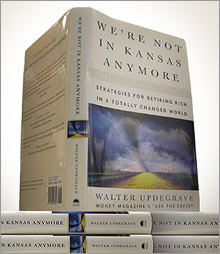|
|

|
|
More information on Updegrave's new book.
|
|
|
|
|
|
|
NEW YORK (CNN/Money) -
I'm 24 and make $37,500 a year. I contribute 10 percent of my salary to my 401(k) and get a 50 percent match from my employer. I also want to build a cash cushion for emergencies, so I'm putting away another $500 a month in a savings account that now has $4,000 in it.
My 401(k) plan will actually give me the 50 percent match on as much as 15 percent of my salary, but I'm unsure whether I should put less in my emergency account and increase my 401(k) contribution or stick with my current plan. What do you think I should do?
-- Kimberly Benefield, Valdosta, Georgia
I'm all for building up a cash cushion to handle life's little surprises like layoffs or unanticipated expenses. But I also think that passing up that 50 percent match is like walking away from free money, which I am constitutionally loathe to do.
Fortunately, I think there's a very nice compromise solution for you that can help you get more out of your 401(k) and still allow you to build your emergency fund, if a bit more slowly.
Here's what I recommend.
Increase your 401(k) contribution to 15 percent of salary. At a 10 percent level, you're already salting away $3,750 a year. By ratcheting up your contribution another 5 percent of salary, you'll be kicking in an additional $1,875, plus you'll be gaining another $937.50 from the employer match.
Going from the 10 percent to 15 percent 401(k) contribution will require an extra $156.25 a month. Deduct that from the $500 you were already devoting your emergency account, and you still have $343.75 a month to put into that account. (Actually, you'd have a bit more, if you figure in the additional tax savings you get by contributing the larger amount to the 401(k).)
The result: you increase the amount of money you effectively save each month without having to shell out more bucks.
Here's why. Had you stuck to your old arrangement, you would have saved $3,750 a year in your 401(k) plus $6,000 annually in your emergency account ($500 a month) for a total of $9,750. Factor in the $1,875 employer match an you would effectively be saving $11,625.
By moving more of your savings to the 401(k) where it gets a 50 percent match, you're still putting out the same number of bucks at your end. But your employer is kicking more. So you're effectively saving $12,562.50 a year, the $937.50 difference being the additional employer match.
So you're netting almost an extra grand a year. To paraphrase the late great Senator Everett Dirksen (who, admittedly was dealing in bigger numbers), a thousand here, a thousand there, and pretty soon you're talking about real money.
Granted, this means it will take you a little longer to accumulate that emergency fund. But if you're shooting at a fund of $10,000 to $15,000, we're not talking about too much extra time. Seems to me getting the extra dough is worth the wait.
Once you have a comfortable cushion, then...
I'll leave you with one other tip. Once you've got your cash cushion inflated to a comfortable level, you ought to consider sticking the money that would have gone to that fund into a Roth IRA.
You contribute after-tax dollars to a Roth, so you won't get the upfront tax break that you would with a 401(k) or a traditional IRA. But you get to pull the money out tax-free at retirement, as opposed to paying tax on both your contributions and earnings with a 401(k) and traditional IRA. (For more on how Roths work, who is eligible for them and how much one can contribute, click here).
That "pay your taxes now, pull the money out tax-free later" arrangement can be a real sweet deal, particularly for young people whose earnings will increase and likely push them into higher tax brackets by retirement time. In effect, you'll be arbitraging the tax system: paying the tab now when your tax rate is low and avoiding it later when your rate is higher.
Not that that's a given, of course. (What is with taxes?). But even if that ideal scenario doesn't work out, arranging things so that not all your retirement money is at the mercy of whatever the tax rates happen to be when you retire -- a concept I call tax diversification -- will give you more flexibility when you're ready to start making withdrawals from your accounts. And that can translate into real money too.
Walter Updegrave is a senior editor at MONEY Magazine and is the author of "We're Not in Kansas Anymore: Strategies for Retiring Rich in a Totally Changed World."

|